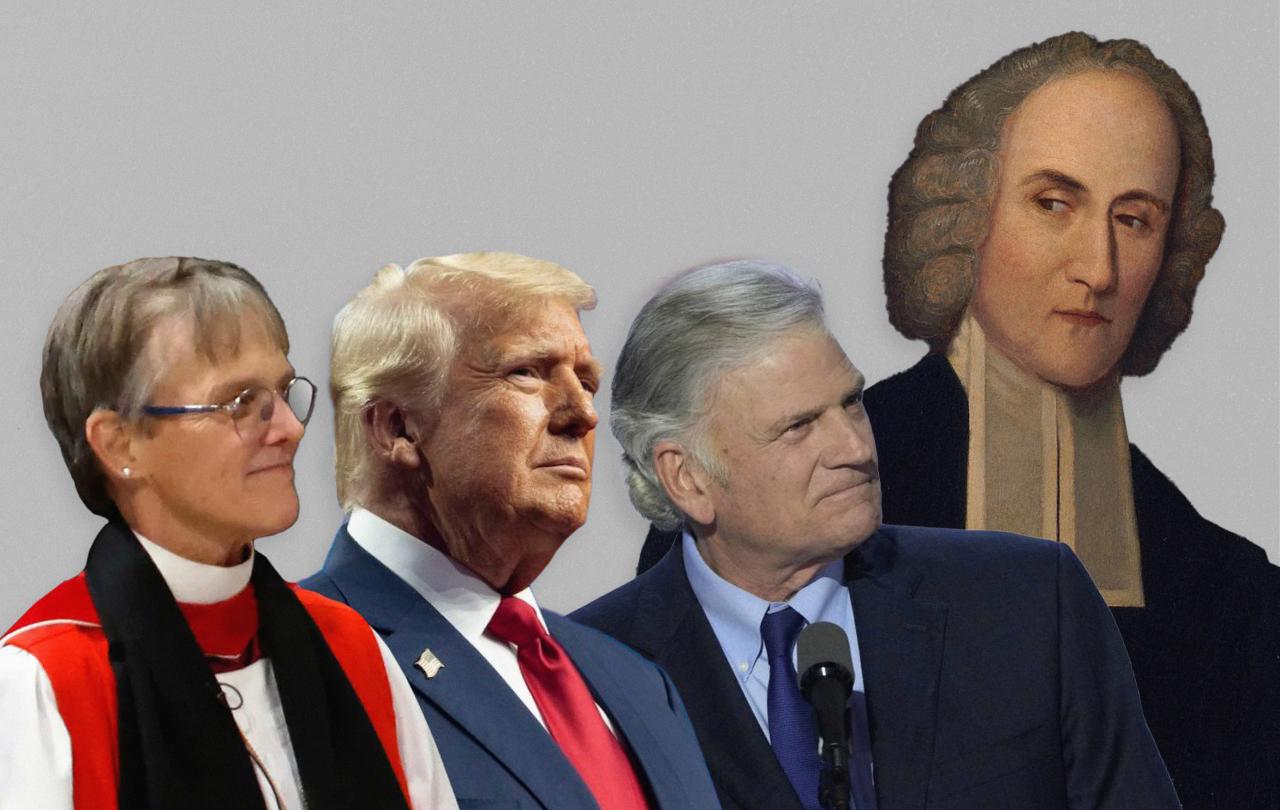
Christian theological language is a fairly constant garnish to the dish that is American political theater. In recent weeks, however, with the rhetoric responding to the initiation of Donald Trump's second term, such language has arguably shifted into a substantial side dish, if not the main course.
At the Inauguration, Rev. Franklin Graham prayed, "Father, when Donald Trump’s enemies thought he was down and out, you and you alone saved his life and raised him up with strength and power by your mighty hand." He compared the new President to Moses and Samuel of the Hebrew Scriptures, and implied that the years of the Biden administration were akin to Israel's years of enslavement in Egypt.
The President himself made a bold claim of divine intervention in Inaugural address:
"I was saved by God to make America great again."
Christians, however, are far from united in this interpretation. Pope Francis suggested prior to the election that American voters were facing a choice between two evils. He has since called Trump's mass deportation plans "a disgrace." The Episcopal Bishop of Washington went viral just after the Inauguration when she called on the newly elected President to amend his rhetoric around sexuality and immigration in the name of mercy: "Our God teaches us that we are to be merciful to the stranger, for we were once strangers in this land."
The discipline of theology can seem like an exercise in evaluating faith language against the grid of personal conviction. Rev. Graham has his theology, Pope Francis his, Bishop Budde hers. But as any true student of theology knows, the tradition is rich with critical tools that go far beyond private taste or political orientation.
Good theology acts as a grammar for the language of Christians. Think of how German or French has rules that keep our subjects and objects aligned and that connect propositions and antecedents. Sentence-diagramming, that dreaded rite of passage for the language student, shows those connections visually on a chalkboard. Cumbersome as they are, such structures allow us to make the most sense possible when we go to put thoughts into words.
So too in the language of faith traditions: we can fail to make sense by ignoring the long evolution of "grammar" that is that tradition's critical reflection on its own faith.
What forms and structures might allow us to evaluate claims about whether or not God's hand is at work in the election and vision of a new U.S. President?
Divine intervention never shows up "full strength," given that it only ever arrives through the words and acts of human beings.
In the eighteenth century, American Puritan theologian Jonathan Edwards weighed in on arguments about whether God was at work in the movement of revivals that we have since taken to calling the First Great Awakening. His careful evaluation of arguments and claims for and against the revivals could serve as a model for evaluating the political theology of our day.
Edwards is most famous for his sermon "Sinners in the Hands of an Angry God," a text that my high school English teacher justly called a stunning piece of rhetoric and an alarming bit of theology. Less famous, though, are the writings that explore the true center of his theological vision. For Edwards, the world was created out of the bounty of God's own character. Call it a theological aesthetic: God delights in the beauty of his own goodness and truth, and so makes a world whose character is, at its best, a reflection of of a good and beautiful God.
This aesthetic runs like a soft bass line through his short treatise The Distinguishing Marks of a Work of the Spirit of God. This work opens with a passage from the first Epistle of John. The writer says that Christians should not believe every spirit, but rather "try the spirits whether they are of God." Edwards is surprised to find that this invitation is not one that his contemporary theological evaluators have taken up. There's his aesthetic running in the background: If God made us to be Godlike, then we ought to be vigilant in our attention to the energies sweeping through the world, and certainly "try them" before we decide to trust or mistrust them as the presence of God's own Spirit.
When he addresses those who deny that the hand of God is at work the Awakening, he takes seriously their criticism that some preachers are excessive, or harmful, or even riddled with errors in their sermons. Edwards doesn't disagree or defend such preachers, but rather reminds the reader that one must consider the distance between the eternally holy and righteous God and the temporally limited and fallible creature. God made us to be Godlike, but that likeness is a calling, not a presumption. For this reason, "If some fall away into gross errors or scandalous practices, it is no argument that the work in general is not the work of the Spirit of God." In fact, "if we look into church history, we shall find no instance of a great revival of religion but what has been attended with many such things." In effect, humans are imperfect receptors of divine transmission. Acknowledgement of our imperfection is not a denial of divine activity. This is, for Edwards, as for the whole of the theological tradition, a key principle of good theological grammar. Divine intervention never shows up "full strength," given that it only ever arrives through the words and acts of human beings.
The "proof" of God's hand, theologically speaking, is not in the strength of one's conviction or in the number of people who hold it.
When he turns from what might negate the claim of divine action to what might affirm it, Edwards says, first of all, that a growing affection for Christian teachings is an integral part of such evidence. "The devil has the most bitter and implacable enmity" against the whole story of the virgin birth and the redemption wrought by Jesus' death and resurrection. If people begin falling in love with the beauty of the story, he suggests, it is a pretty solid indicator that God is at work.
But this alone is not sufficient evidence, if for no other reason, Edwards says, than that there are false prophets who mislead even as they speak in ways that sound pious. For this reason, a love of truth-telling supplies a touchstone for our theological grammar. "If we see that a spirit operates as a spirit of truth, leadings persons to truth, convincing them of those things that are true, we may safely determine it is a right and true spirit." For Edwards, if I speak out loudly in favor of the divinity of Christ while lying about my own actions or intentions, you should not trust that I am a faithful witness to the work of the Holy Spirit.
But the most important of all marks of the work of the Spirit of God is neither of these; or perhaps, it is a mark that lies within and shapes all other evidences. Edwards says that "humble love" of God and fellow humans is the "highest evidence of a true and divine Spirit." The adjective here is important: a love that is self-aggrandizing is not the love that shares in God's own character.
Here again the aesthetic sounds the bass line: God's love changes us like a beautiful memory or a lovely person does. We want to belong there, we want to be like that. If the energy, the spirit, sweeping through a culture is not that sort of energy, then it's likely not the work of the lovingly humble God.
Edwards ends his own treatise by grading the revivals on his grammatical grid, and determining that it is, in fact, the work of God. For our current moment in U.S. society, the evidence is not yet in. Will the Trump administration cause an increase in affection for Christian teachings? Will it explode in an epidemic of truth-telling and a cultural outrage at falsehood? Will the policies and practices of the next four years demonstrate humble love? If so, Christians will have good reason to attest that the interpretations of leaders like Reverend Graham are accurate.
The "proof" of God's hand, theologically speaking, is not in the strength of one's conviction or in the number of people who hold it. It is rather in the humility, Christian devotion, and the divine and neighborly love that grows from the events in question.
On this note, Bishop Budde's admonition invites a reading that not far from the theological grammar that Edwards supplies. "You have felt the providential hand of a loving God," she reminded the President. "In the name of our God, I ask you to have mercy upon the people in our country who are scared now." If it was in fact God's mercy that spared you, it was so that you could be merciful. The proof of providence will be in the pudding of practice, Mr. Trump.
Join with us - Behind the Seen
Seen & Unseen is free for everyone and is made possible through the generosity of our amazing community of supporters.
If you’re enjoying Seen & Unseen, would you consider making a gift towards our work?
Alongside other benefits (book discounts etc.), you’ll receive an extra fortnightly email from me sharing what I’m reading and my reflections on the ideas that are shaping our times.
Graham Tomlin
Editor-in-Chief





